Berg J.M., Tymoczko J.L., Stryer L. Biochemistry
Подождите немного. Документ загружается.

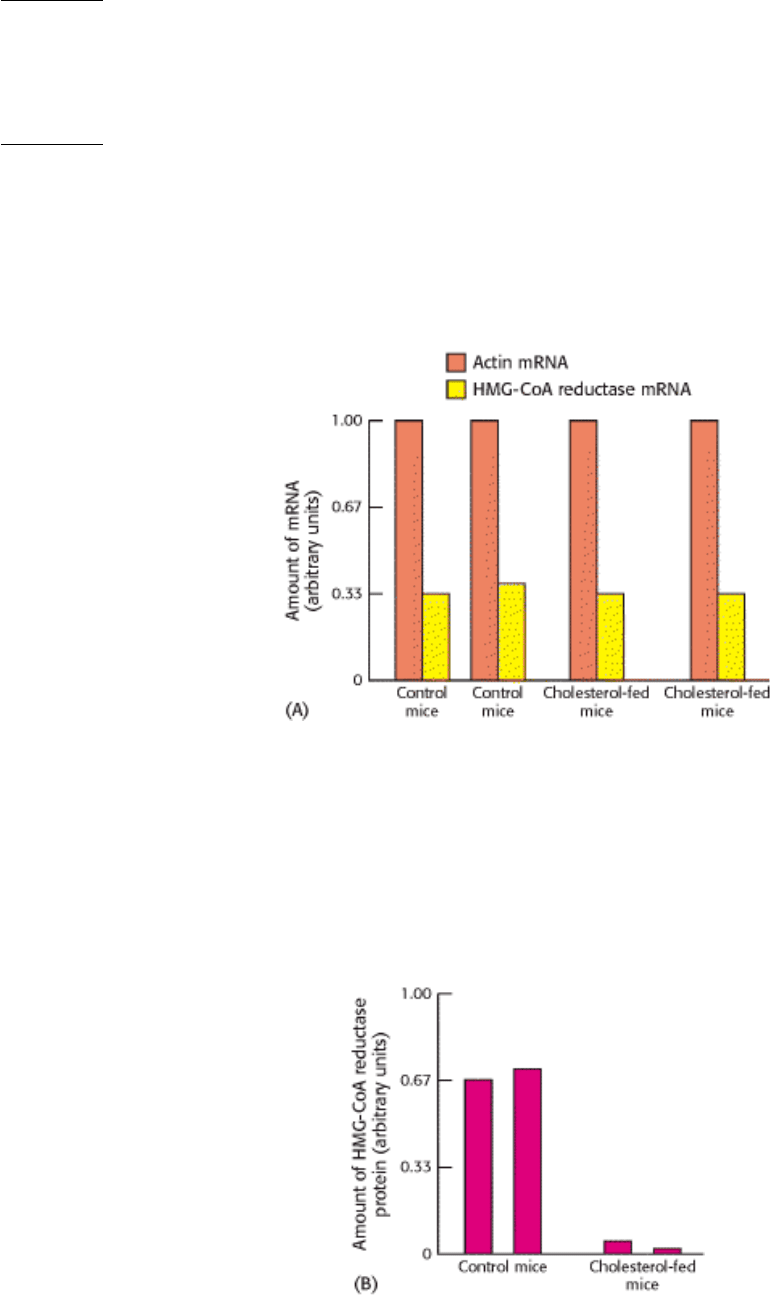
See answer
14.
Demethylation. Methyl amines are often demethylated by cytochrome P450 enzymes. Propose a mechanism for the
formation of methylamine from dimethylamine catalyzed by cytochrome P450. What is the other product?
See answer
Data Interpretation and Chapter Integration Problems
15.
Cholesterol feeding. Mice were divided into four groups, two of which were fed a normal diet and two of which
were fed a cholesterol-rich diet. HMG-CoA reductase mRNA and protein from liver were then isolated and
quantified. Graph A shows the results of the mRNA isolation.
(a) What is the effect of cholesterol feeding on the amount of HMG-CoA reductase mRNA?
(b) What is the purpose of also isolating the mRNA for the protein actin, which is not under the control of the sterol
response element?
HMG-CoA reductase protein was isolated by precipitation with a monoclonal antibody to HMG-CoA reductase.
The amount of HMG-CoA protein in each group is shown in graph B.
(c) What is the effect of the cholesterol diet on the amount of HMG-CoA reductase protein?
(d) Why is this result surprising in light of the results in graph A?

(e) Suggest possible explanations for the results shown in graph B.
See answer
III. Synthesizing the Molecules of Life 26. The Biosynthesis of Membrane Lipids and Steroids
Selected Readings
Where to start
D.E. Vance and H. Van den Bosch. 2000. Cholesterol in the year 2000 Biochim. Biophys. Acta 1529: 1-8. (PubMed)
M.S. Brown and J.L. Goldstein. 1986. A receptor-mediated pathway for cholesterol homeostasis Science 232: 34-47.
(PubMed)
M.S. Brown and J.L. Goldstein. 1984. How LDL receptors influence cholesterol and atherosclerosis Sci. Am. 25l: (5) 58-
66.
L. Chan. 1992. Apolipoprotein B, the major protein component of triglyceride-rich and low density lipoproteins J. Biol.
Chem. 267: 25621-25624. (PubMed)
A. Endo. 1992. The discovery and development of HMG-CoA reductase inhibitors J. Lipid Res. 33: 1569-1582.
(PubMed)
S. Hakomori.. 1986. Glycosphingolipids Sci. Am. 254: (5) 44-53. (PubMed)
Books
Vance, D. E., and Vance, J. E. (Eds.), 1996. Biochemistry of Lipids, Lipoproteins and Membranes. Elsevier.
Striver, C. R., Beaudet, A. L., Sly, W. S., Valle, D., Stanbury, J. B., Wyngaarden, J. B., and Fredrickson, D. S. (Eds.),
1995. The Metabolic Basis of Inherited Diseases (7th ed.). McGraw-Hill.
Phospholipids and sphingolipids
A. Huwilera, T. Kolterb, J. Pfeilschiftera, and K. Sandhoffb. 2000. Physiology and pathophysiology of sphingolipid
metabolism and signaling Biochim. Biophys. Acta 1485: 63-99. (PubMed)
A. Lykidis and S. Jackowski. 2000. Regulation of mammalian cell membrane biosynthesis Prog. Nucleic Acid Res. Mol.
Biol. 65: 361-393. (PubMed)
G.M. Carman and G.M. Zeimetz. 1996. Regulation of phospholipid biosynthesis in the yeast Saccharomyces cerevisiae
J. Biol. Chem. 271: 13293-13296. (PubMed)
S.A. Henry and J.L. Patton-Vogt. 1998. Genetic regulation of phospholipid metabolism: Yeast as a model eukaryote
Prog. Nucleic Acid Res. Mol. Biol. 61: 133-179. (PubMed)
C. Kent. 1995. Eukaryotic phospholipid biosynthesis Annu. Rev. Biochem. 64: 315-343. (PubMed)
S.M. Prescott, G.A. Zimmerman, D.M. Stafforini, and T.M. McIntyre. 2000. Platelet-activating factor and related lipid
mediators Annu. Rev. Biochem. 69: 419-445. (PubMed)
Biosynthesis of cholesterol and steroids
J.L. Goldstein and M.S. Brown. 1990. Regulation of the mevalonate pathway Nature 343: 425-430. (PubMed)
R.G. Gardner, H. Shan, S.P.T. Matsuda, and R.Y. Hampton. 2001. An oxysterol-derived positive signal for 3-hydroxy-3-

methylglutaryl-CoA reductase degradation in yeast J. Biol. Chem. 276: 8681-8694. (PubMed)
E.S. Istvan and J. Deisenhofer. 2001. Structural mechanism for statin inhibition of HMG-CoA reductase Science 292:
1160-1164. (PubMed)
G.C. Ness and C.M. Chambers. 2000. Feedback and hormonal regulation of hepatic 3-hydroxy-3-methylglutaryl
coenzyme A reductase: The concept of cholesterol buffering capacity Proc. Soc. Exp. Biol. Med. 224: 8-19. (PubMed)
P. Libby, M. Aikawa, and U. Schonbeck. 2000. Cholesterol and atherosclerosis Biochim. Biophys. Acta 1529: 299-309.
(PubMed)
S. Yokoyama. 2000. Release of cellular cholesterol: Molecular mechanism for cholesterol homeostasis in cells and in the
body Biochim. Biophys. Acta 1529: 231-244. (PubMed)
S.R. Cronin, A. Khoury, D.K. Ferry, and R.Y. Hampton. 2000. Regulation of HMG-CoA reductase degradation requires
the P-type ATPase Cod1p/Spf1p J. Cell Biol. 148: 915-924. (PubMed)
P.A. Edwards, D. Tabor, H.R. Kast, and A. Venkateswaran. 2000. Regulation of gene expression by SREBP and SCAP
Biochim. Biophys. Acta 1529: 103-113. (PubMed)
E.S. Istvan, M. Palnitkar, S.K. Buchanan, and J. Deisenhofer. 2000. Crystal structure of the catalytic portion of human
HMG-CoA reductase: Insights into regulation of activity and catalysis EMBO J. 19: 819-830. (PubMed)
L. Tabernero, D.A. Bochar, V.W. Rodwell, and C.V. Stauffacher. 1999. Substrate-induced closure of the flap domain in
the ternary complex structures provides insights into the mechanism of catalysis by 3-hydroxy-3-methylglutaryl-CoA
reductase Proc. Natl. Acad. Sci. USA. 96: 7167-7171. (PubMed) (Full Text in PMC)
D. Fass, S. Blacklow, P.S. Kim, and J.M. Berger. 1997. Molecular basis of familial hypercholesterolaemia from structure
of LDL receptor module Nature 388: 691-693. (PubMed)
H. Jeon, W. Meng, J. Takagi, M.J. Eck, T.A. Springer, and S.C. Blacklow. 2001. Implications for familial
hypercholesterolemia from the structure of the LDL receptor YWTD-EGF domain pair Nat. Struct. Biol. 8: 499-504.
(PubMed)
Lipoproteins and their receptors
C.G. Brouillette, G.M. Anantharamaiah, J.A. Engler, and D.W. Borhani. 2001. Structural models of human
apolipoprotein A-I: A critical analysis and review Biochem. Biophys. Acta 1531: 4-46. (PubMed)
T. Hevonoja, M.O. Pentikainen, M.T. Hyvonen, P.T. Kovanen, and M. Ala-Korpela. 2000. Structure of low density
lipoprotein (LDL) particles: Basis for understanding molecular changes in modified LDL Biochim. Biophys. Acta 1488:
189-210. (PubMed)
D.L. Silver, X.C. Jiang, T. Arai, C. Bruce, and A.R. Tall. 2000. Receptors and lipid transfer proteins in HDL metabolism
Ann. N. Y. Acad. Sci. 902: 103-111. (PubMed)
J. Nimpf and W.J. Schneider. 2000. From cholesterol transport to signal transduction: Low density lipoprotein receptor,
very low density lipoprotein receptor, and apolipoprotein E receptor-2 Biochim. Biophys. Acta 1529: 287-298. (PubMed)
D.W. Borhani, D.P. Rogers, J.A. Engler, and C.G. Brouillette. 1997. Crystal structure of truncated human apolipoprotein
A-I suggests a lipid-bound conformation Proc. Natl. Acad. Sci. USA. 94: 12291-12296. (PubMed) (Full Text in PMC)
C. Wilson, M.R. Wardell, K.H. Weisgraber, R.W. Mahley, and D.A. Agard. 1991. Three-dimensional structure of the
LDL receptor-binding domain of human apolipoprotein E Science 252: 1817-1822. (PubMed)
A.S. Plump, J.D. Smith, T. Hayek, K. Aalto-Setälä, A. Walsh, J.G. Verstuyft, E.M. Rubin, and J.L. Breslow. 1992.
Severe hypercholesterolemia and atherosclerosis in apolipoprotein E-deficient mice created by homologous

recombination in ES cells Cell 71: 343-353. (PubMed)
T.C. Sudhof, J.L. Goldstein, M.S. Brown, and D.W. Russell. 1985. The LDL receptor gene: A mosaic of exons shared
with different proteins Science 228: 815-822. (PubMed)
Oxygen activation and P450 catalysis
M. Ingelman-Sundberg, M. Oscarson, and R.A. McLellan. 1999. Polymorphic human cytochrome P450 enzymes: An
opportunity for individualized drug treatment Trends Pharmacol. Sci. 20: 342-349. (PubMed)
D.R. Nelson. 1999. Cytochrome P450 and the individuality of species Arch. Biochem. Biophys. 369: 1-10. (PubMed)
L.L. Wong. 1998. Cytochrome P450 monooxygenases Curr. Opin. Chem. Biol. 2: 263-268. (PubMed)
M.S. Denison and J.P. Whitlock. 1995. Xenobiotic-inducible transcription of cytochrome P450 genes J. Biol. Chem. 270:
18175-18178. (PubMed)
T.L. Poulos. 1995. Cytochrome P450 Curr. Opin. Struct. Biol. 5: 767-774. (PubMed)
A.D. Vaz and M.J. Coon. 1994. On the mechanism of action of cytochrome P450: Evaluation of hydrogen abstraction in
oxygendependent alcohol oxidation Biochemistry 33: 6442-6449. (PubMed)
F.J. Gonzalez and D.W. Nebert. 1990. Evolution of the P450 gene superfamily: Animal-plant "warfare," molecular drive
and human genetic differences in drug oxidation Trends Genet. 6: 182-186. (PubMed)
III. Synthesizing the Molecules of Life
27. DNA Replication, Recombination, and Repair
Perhaps the most exciting aspect of the structure of DNA deduced by Watson and Crick was, as expressed in their words,
that the "specific pairing we have postulated immediately suggests a possible copying mechanism for the genetic
material." A double helix separated into two single strands can be replicated because each strand serves as a template on
which its complementary strand can be assembled (Figure 27.1). Although this notion of how DNA is replicated is
absolutely correct, the doublehelical structure of DNA poses a number of challenges to replication, as does the need for
extremely faithful copying of the genetic information.
1. The two strands of the double helix have a tremendous affinity for one another, created by the cooperative effects of
the many hydrogen bonds that hold adjacent base pairs together. Thus, a mechanism is required for separating the strands
in a local region to provide access to the bases that act as templates. Specific proteins melt the double helix at specific
sites to initiate DNA replication, and other enzymes, termed helicases, use the free energy of ATP hydrolysis to move
this melted region along the double helix as replication progresses.
2. The DNA helix must be unwound to separate the two strands. The local unwinding in one region leads to stressful
overwinding in surrounding regions (Figure 27.2). Enzymes termed topoisomerases introduce supercoils that release the
strain caused by overwinding.
3. DNA replication must be highly accurate. As noted in Chapter 5, the free energies associated with base pairing within
the double helix suggest that approximately 1 in 10
4
bases incorporated will be incorrect. Yet, DNA replication has an
error rate estimated to be 1 per 10
10
nucleotides. As we shall see, additional mechanisms allow proofreading of the
newly formed double helix.
4. DNA replication must be very rapid, given the sizes of the genomes and the rates of cell division. The E. coli genome
contains 4.8 million base pairs and is copied in less than 40 minutes. Thus, 2000 bases are incorporated per second. We
shall examine some of the properties of the macromolecular machines that replicate DNA with such high accuracy and
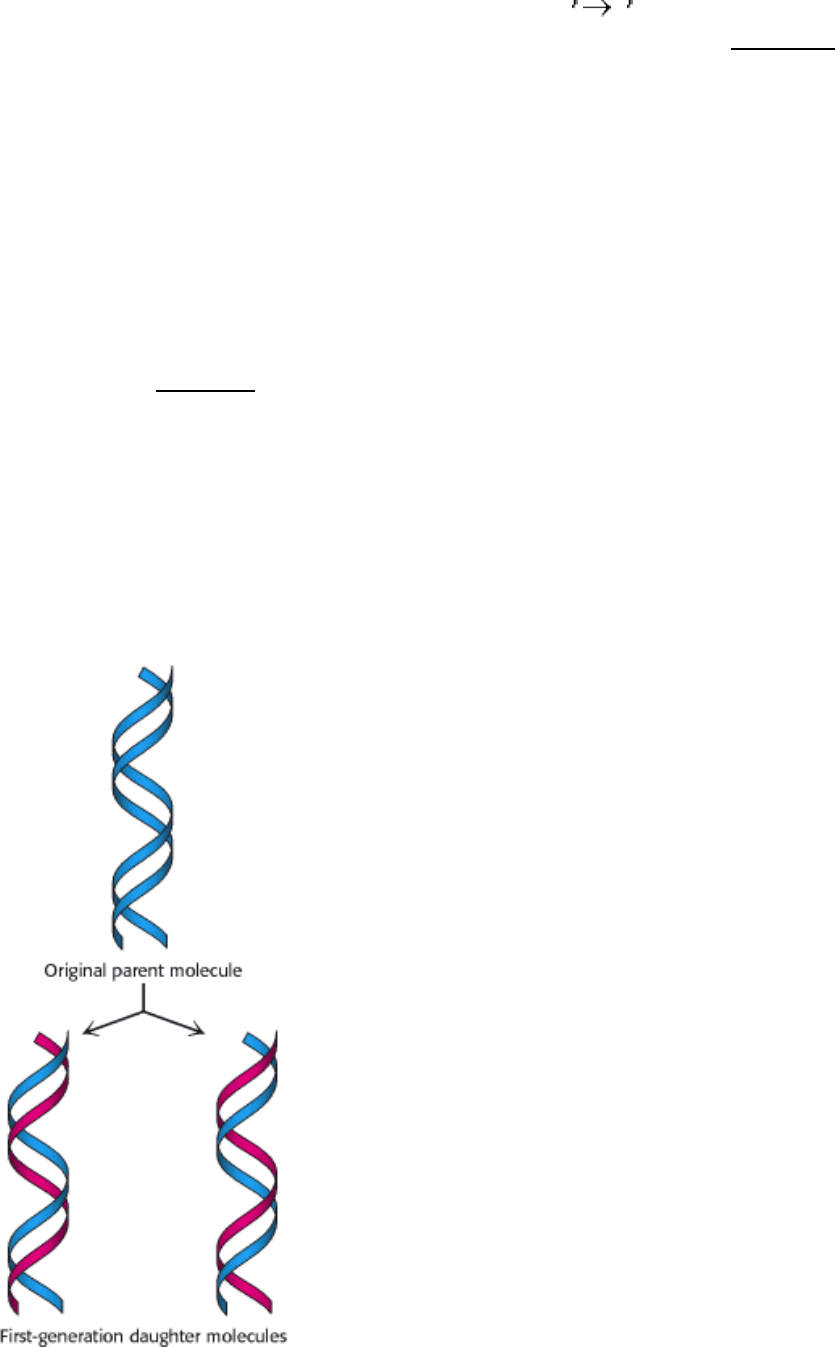
speed.
5. The enzymes that copy DNA polymerize nucleotides in the 5 3 direction. The two polynucleotide strands of DNA
run in opposite directions, yet both strands appear to grow in the same direction (Figure 27.3). Further analysis reveals
that one strand is synthesized in a continuous fashion, whereas the opposite strand is synthesized in fragments in a
discontinuous fashion. The synthesis of each fragment must be initiated in an independent manner, and then the
fragments must be linked together. The DNA replication apparatus includes enzymes for these priming and ligation
reactions.
6. The replication machinery alone cannot replicate the ends of linear DNA molecules, so a mechanism is required to
prevent the loss of sequence information with each replication. Specialized structures called telomeres are added by
another enzyme to maintain the information content at chromosome ends.
7. Most components of the DNA replication machinery serve to preserve the integrity of a DNA sequence to the
maximum possible extent, yet a variety of biological processes require DNA formed by the exchange of material
between two parent molecules. These processes range from the development of diverse antibody sequences in the
immune system (Chapter 33) to the integration of viral genomes into host DNA. Specific enzymes, termed
recombinases, facilitate these rearrangements.
8. After replication, ultraviolet light and a range of chemical species can damage DNA in a variety of ways. All
organisms have enzymes for detecting and repairing harmful DNA modifications. Agents that introduce chemical lesions
into DNA are key factors in the development of cancer, as are defects in the repair systems that correct these lesions.
We begin with a review of the structural properties of the DNA double helix.
III. Synthesizing the Molecules of Life 27. DNA Replication, Recombination, and Repair
Figure 27.1. DNA Replication. The double-helical structure immediately suggests how DNA is replicated.
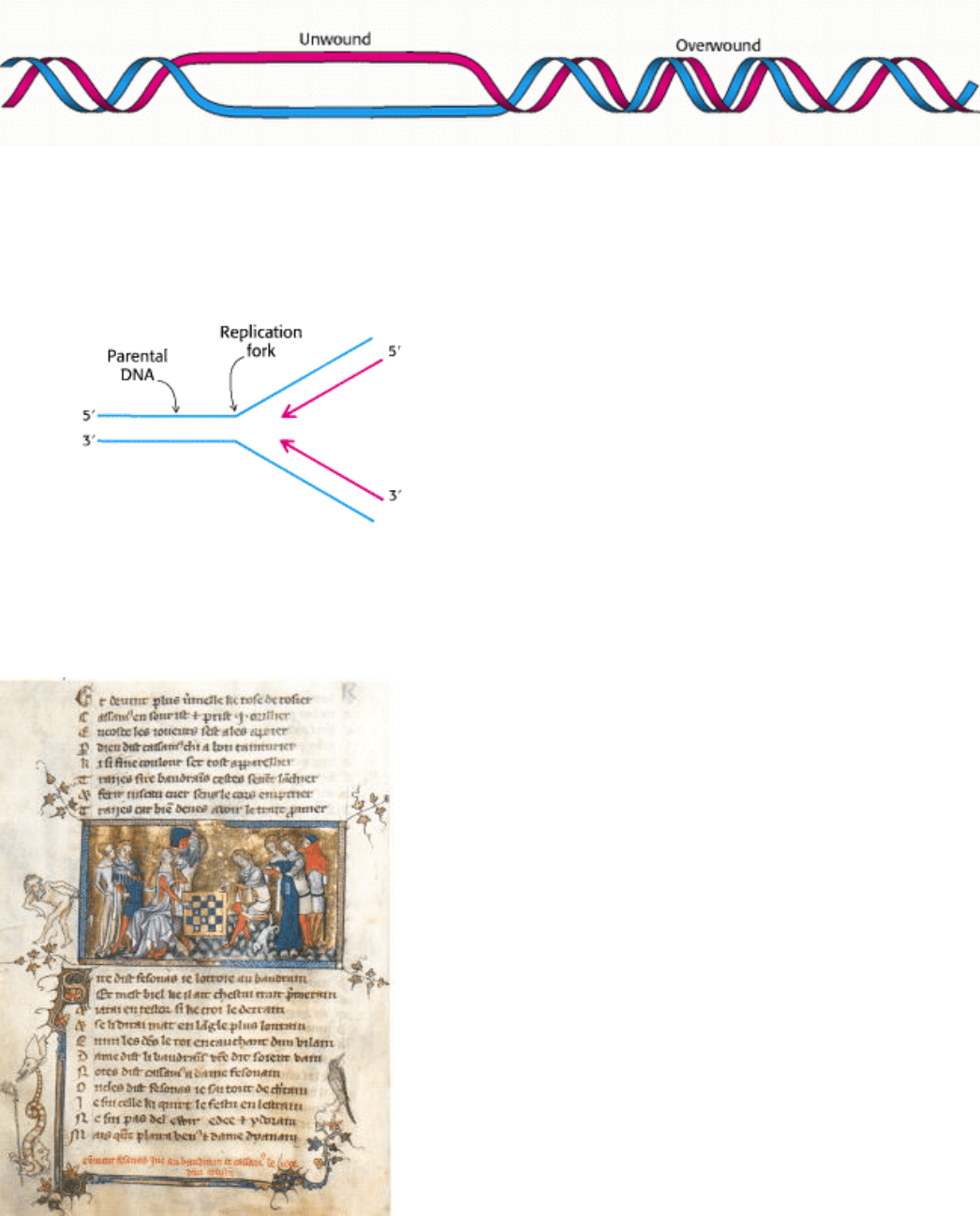
III. Synthesizing the Molecules of Life 27. DNA Replication, Recombination, and Repair
Figure 27.2. Consequences of Strand Separation. DNA must be locally unwound to expose single-stranded templates
for replication. This unwinding puts a strain on the molecule by causing the overwinding of nearby regions.
III. Synthesizing the Molecules of Life 27. DNA Replication, Recombination, and Repair
Figure 27.3. DNA Replication At Low Resolution. On cursory examination, both strands of a DNA template appear to
replicate continuously in the same direction.
III. Synthesizing the Molecules of Life 27. DNA Replication, Recombination, and Repair
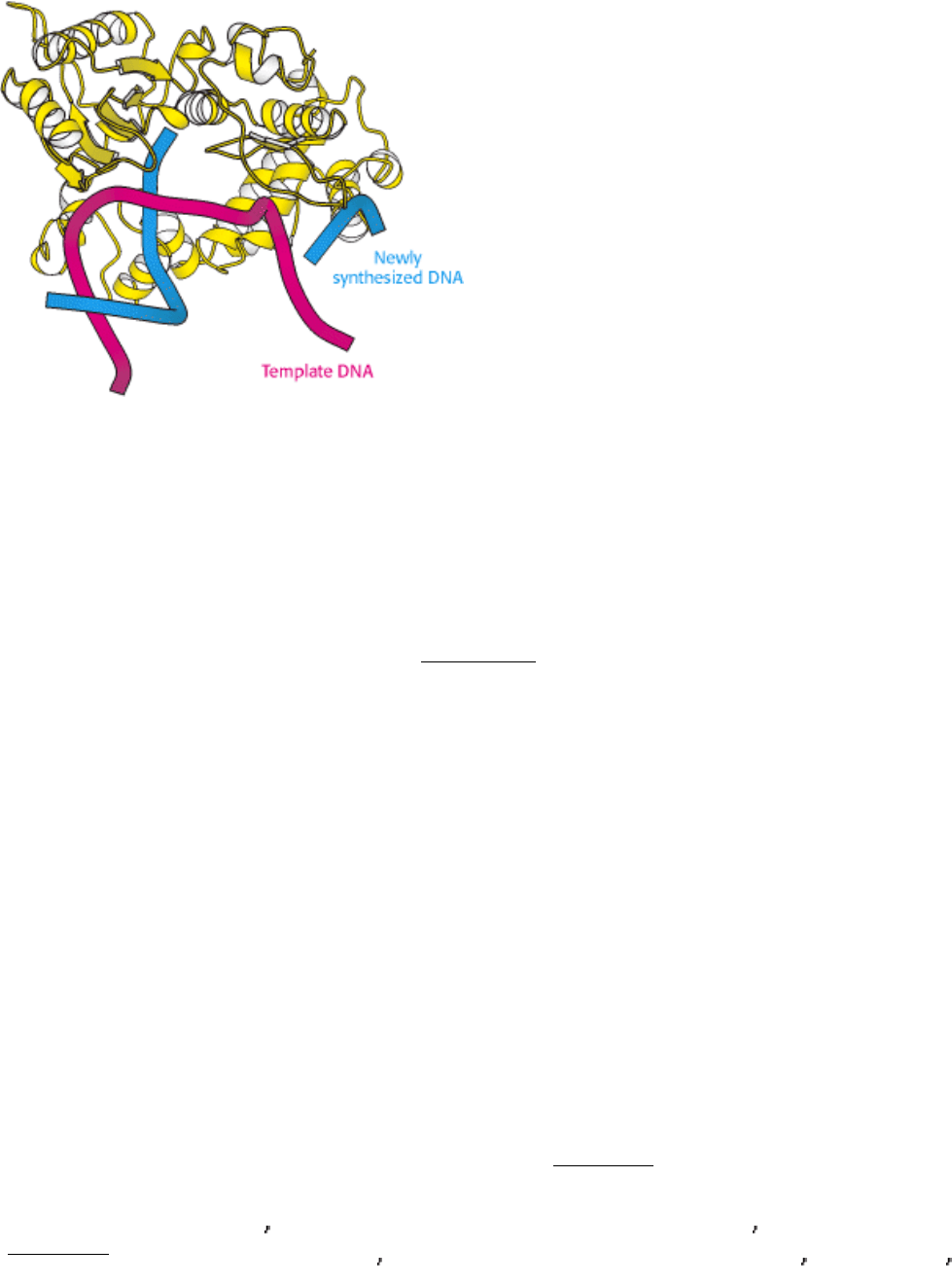
Faithful copying is essential to the storage of genetic information. With the precision of a diligent monk copying an
illuminated manuscript, a DNA polymerase (below) copies DNA strands, preserving the precise sequence of bases with
very few errors. [(Left) The Pierpont Morgan Library/ Art Resource.]
III. Synthesizing the Molecules of Life 27. DNA Replication, Recombination, and Repair
27.1. DNA Can Assume a Variety of Structural Forms
The double-helical structure of DNA deduced by Watson and Crick immediately suggested how genetic information is
stored and replicated. As was discussed earlier (Section 5.2.1), the essential features of their model are:
1. Two polynucleotide chains running in opposite directions coil around a common axis to form a right-handed double
helix.
2. Purine and pyrimidine bases are on the inside of the helix, whereas phosphate and deoxyribose units are on the outside.
3. Adenine (A) is paired with thymine (T), and guanine (G) with cytosine (C). An A-T base pair is held together by two
hydrogen bonds, and that of a G-C base pair by three such bonds.
27.1.1. A-DNA Is a Double Helix with Different Characteristics from Those of the More
Common B-DNA
Watson and Crick based their model (known as the B-DNA helix) on x-ray diffraction patterns of DNA fibers, which
provided information about properties of the double helix that are averaged over its constituent residues. The results of x-
ray diffraction studies of dehydrated DNA fibers revealed a different form called A-DNA, which appears when the
relative humidity is reduced to less than about 75%. A-DNA, like B-DNA, is a right-handed double helix made up of
antiparallel strands held together by Watson-Crick base-pairing. The A helix is wider and shorter than the B helix, and its
base pairs are tilted rather than perpendicular to the helix axis (Figure 27.4).
Many of the structural differences between B-DNA and A-DNA arise from different puckerings of their ribose units
(Figure 27.5). In A-DNA, C-3 lies out of the plane (a conformation referred to as C-3 -endo) formed by the other four
atoms of the furanose ring; in B-DNA, C-2
lies out of the plane (a conformation called C-2 -endo). The C-3 -endo
puckering in A-DNA leads to a 19-degree tilting of the base pairs away from the normal to the helix. The phosphates and
other groups in the A helix bind fewer H
2
O molecules than do those in B-DNA. Hence, dehydration favors the A form.
The A helix is not confined to dehydrated DNA. Double-stranded regions of RNA and at least some RNA-DNA hybrids

adopt a double-helical form very similar to that of A-DNA. The position of the 2 -hydroxyl group of ribose prevents
RNA from forming a classic Watson-Crick B helix because of steric hindrance (Figure 27.6): the 2 -oxygen atom would
come too close to three atoms of the adjoining phosphate group and one atom in the next base. In an A-type helix, in
contrast, the 2
-oxygen projects outward, away from other atoms.
27.1.2. The Major and Minor Grooves Are Lined by Sequence-Specific Hydrogen-
Bonding Groups
Double-helical nucleic acid molecules contain two grooves, called the major groove and the minor groove. These
grooves arise because the glycosidic bonds of a base pair are not diametrically opposite each other (Figure 27.7). The
minor groove contains the pyrimidine O-2 and the purine N-3 of the base pair, and the major groove is on the opposite
side of the pair. The methyl group of thymine also lies in the major groove. In B-DNA, the major groove is wider (12
versus 6 Å) and deeper (8.5 versus 7.5 Å) than the minor groove (Figure 27.8).
Each groove is lined by potential hydrogen-bond donor and acceptor atoms that enable specific interactions with proteins
(see Figure 27.7). In the minor groove, N-3 of adenine or guanine and O-2 of thymine or cytosine can serve as hydrogen
acceptors, and the amino group attached to C-2 of guanine can be a hydrogen donor. In the major groove, N-7 of guanine
or adenine is a potential acceptor, as are O-4 of thymine and O-6 of guanine. The amino groups attached to C-6 of
adenine and C-4 of cytosine can serve as hydrogen donors. Note that the major groove displays more features that
distinguish one base pair from another than does the minor groove. The larger size of the major groove in B-DNA makes
it more accessible for interactions with proteins that recognize specific DNA sequences.
27.1.3. The Results of Studies of Single Crystals of DNA Revealed Local Variations in
DNA Structure
X-ray analyses of single crystals of DNA oligomers had to await the development of techniques for synthesizing large
amounts of DNA fragments with defined base sequences. X-ray analyses of single crystals of DNA at atomic resolution
revealed that DNA exhibits much more structural variability and diversity than formerly envisaged.
The x-ray analysis of a crystallized DNA dodecamer by Richard Dickerson and his coworkers revealed that its overall
structure is very much like a B-form Watson-Crick double helix. However, the dodecamer differs from the Watson-Crick
model in not being uniform; there are rather large local deviations from the average structure. The Watson-Crick model
has 10 residues per complete turn, and so a residue is related to the next along a chain by a rotation of 36 degrees. In
Dickerson's dodecamer, the rotation angles range from 28 degrees (less tightly wound) to 42 degrees (more tightly
wound). Furthermore, the two bases of many base pairs are not perfectly coplanar (Figure 27.9). Rather, they are
arranged like the blades of a propeller. This deviation from the idealized structure, called propeller twisting, enhances
the stacking of bases along a strand. These and other local variations of the double helix depend on base sequence. A
protein searching for a specific target sequence in DNA may sense its presence through its effect on the precise shape of
the double helix.
27.1.4. Z-DNA Is a Left-Handed Double Helix in Which Backbone Phosphates Zigzag
Alexander Rich and his associates discovered a third type of DNA helix when they solved the structure of dCGCGCG.
They found that this hexanucleotide forms a duplex of antiparallel strands held together by Watson-Crick base-pairing,
as expected. What was surprising, however, was that this double helix was left-handed, in contrast with the right-handed
screw sense of the A and B helices. Furthermore, the phosphates in the backbone zigzagged; hence, they called this new
form Z-DNA (Figure 27.10).
The Z-DNA form is adopted by short oligonucleotides that have sequences of alternating pyrimidines and purines. High
salt concentrations are required to minimize electrostatic repulsion between the backbone phosphates, which are closer to
each other than in A- and B-DNA. Under physiological conditions, most DNA is in the B form. Although the biological

role of Z-DNA is still under investigation, its existence graphically shows that DNA is a flexible, dynamic molecule. The
properties of A-, B-, and Z-DNA are compared in Table 27.1.
Primer
The initial segment of a polymer that is to be extended on which
elongation depends.
Template
A sequence of DNA or RNA that directs the synthesis of a
complementary sequence.
III. Synthesizing the Molecules of Life 27. DNA Replication, Recombination, and Repair 27.1. DNA Can Assume a Variety of Structural Forms
Figure 27.4. B-Form and A-Form DNA.
Space-filling models of ten base pairs of B-form and A-form DNA depict
their right-handed helical structures. The B-form helix is longer and narrower than the A-form helix. The carbon
atoms of the backbone are shown in white.
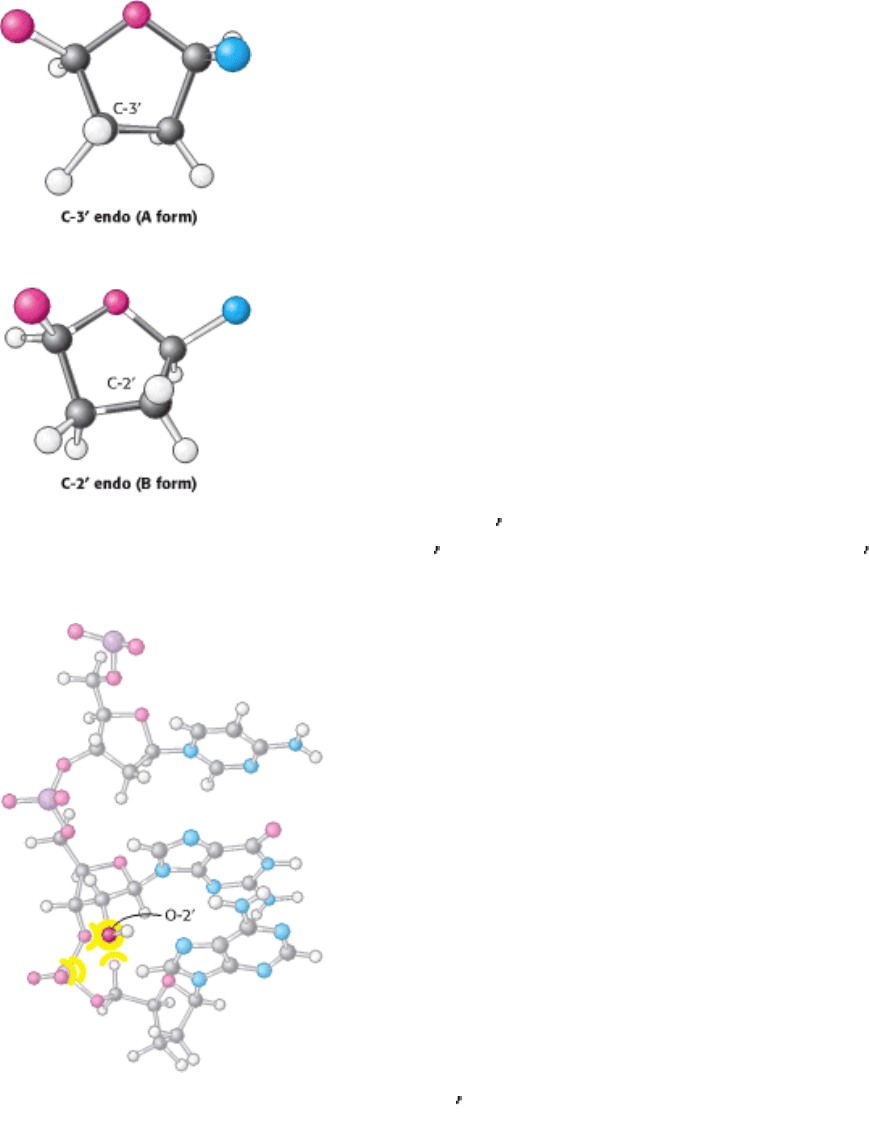
III. Synthesizing the Molecules of Life 27. DNA Replication, Recombination, and Repair 27.1. DNA Can Assume a Variety of Structural Forms
Figure 27.5. Sugar Puckers. In A-form DNA, the C-3
carbon atom lies above the approximate plane defined by the
four other sugar nonhydrogen atoms (called C-3
endo). In B-form DNA, each ribose is in a C-2 -endo conformation.
III. Synthesizing the Molecules of Life 27. DNA Replication, Recombination, and Repair 27.1. DNA Can Assume a Variety of Structural Forms
Figure 27.6. Steric Clash. The introduction of a 2
-hydroxyl group into a B-form structure leads to several steric clashes
with nearby atoms.
